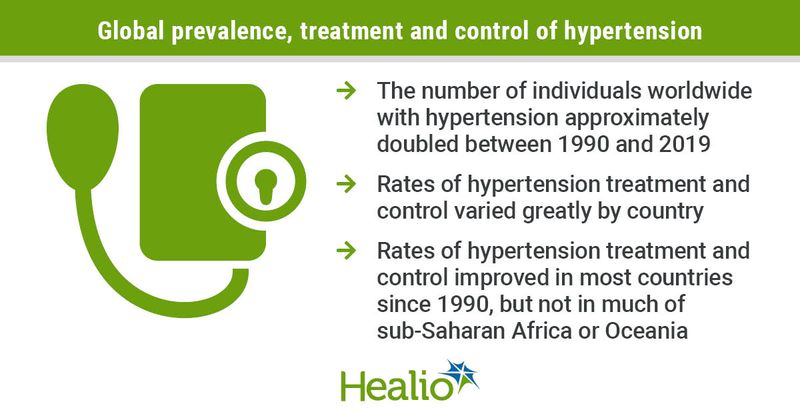Hypertension detection, treatment, control varies widely across countries
Hypertension detection, treatment and control varies widely across different countries, with some middle-income countries outperforming high-income nations, researchers reported in The Lancet.
“Comparable data on hypertension detection, treatment and control are needed to learn from good practice to guide health system programs,” Bin Zhou, PhD, research fellow in health analytics and machine learning in the School of Public Health at Imperial College London and researcher for the NCD Risk Factor Collaboration, and colleagues wrote. “No comparable global data exist to assess which countries have high vs. low rates of detection, treatment and control and how these measures have changed over time.”

Researchers evaluated data from 1990 to 2019 on individuals (aged 30 to 79 years) from population-representative studies with BP measurements and BP treatment data. Hypertension was defined as an individual with systolic BP of > 140 mm Hg, diastolic BP > 90 mm Hg or taking medication for hypertension. Using this information, researchers estimated hypertension prevalence and the number of individuals with hypertension with a previous diagnosis, those taking medication for hypertension and those with hypertension controlled to below 140/90 mm Hg.
From 1990 to 2019, the number of individuals aged 30 to 79 years with hypertension doubled from 331 million women and 317 million men to 626 million women and 652 million men. The lowest age-standardized hypertension prevalence was observed in Canada and Peru for both sexes, in Taiwan, South Korea, Japan, Switzerland, Spain and the U.K. for women and in low-income and middle-income countries such as Eritrea, Bangladesh, Ethiopia and Solomon Islands for men.
Prevalence, treatment, control
Researchers observed hypertension prevalence surpassing 50% in two countries for women and in nine countries for men. Reports of a previous hypertension diagnosis in 2019 were observed among 59% of women and 49% of men globally, with 47% of women and 38% of men treated for it. In addition, hypertension control rates among individuals with hypertension in 2019 were 23% for women and 18% for men.
South Korea, Canada and Iceland demonstrated the highest hypertension treatment (> 70%) and control (> 50%) followed by the U.S., Costa Rica, Germany, Portugal and Taiwan. However, in Nepal, Indonesia and some sub-Saharan African and Oceania countries, hypertension treatment rates were < 25% for women and < 20% for men. These countries also demonstrated hypertension control rates of < 10% for women and men, and there were similar control rates for men in parts of north Africa, central and south Asia and eastern Europe.
Global progress slow
“Despite medical and pharmacological advances over decades, global progress in hypertension management has been slow, and the vast majority of people with hypertension remain untreated, with large disadvantages in low- and middle-income countries,” Majid Ezzati, PhD, FMedSci, chair in global environmental health at Imperial College London, said in a press release. “Our analysis has revealed good practice in diagnosing and treating hypertension not just in high-income countries but also in middle-income countries. These successes show that preventing high blood pressure and improving its detection, treatment, and control are feasible across low- and middle-income settings if international donors and national governments commit to addressing this major cause of disease and death.”
According to the researchers, hypertension treatment and control rates improved in many countries since 1990, but there was little change in most sub-Saharan Africa and Oceania countries. The largest hypertension treatment and control rate improvements occurred in high-income countries, central Europe and certain counties whose income status improved during the study, including Costa Rica, Taiwan, Kazakhstan, South Africa, Brazil, Chile, Turkey and Iran.
“Universal health insurance has been instrumental in achieving high effective coverage but should be complemented with primary care strengthening, evidence-based hypertension guidelines that are up to date and are adapted to the country contexts, health workforce training and a robust system of drug procurement and distribution,” the researchers wrote. “Programs should also be regularly assessed, both at the population level, as our work has done, and in health facilities to ensure accountability and stimulate improvement.”
